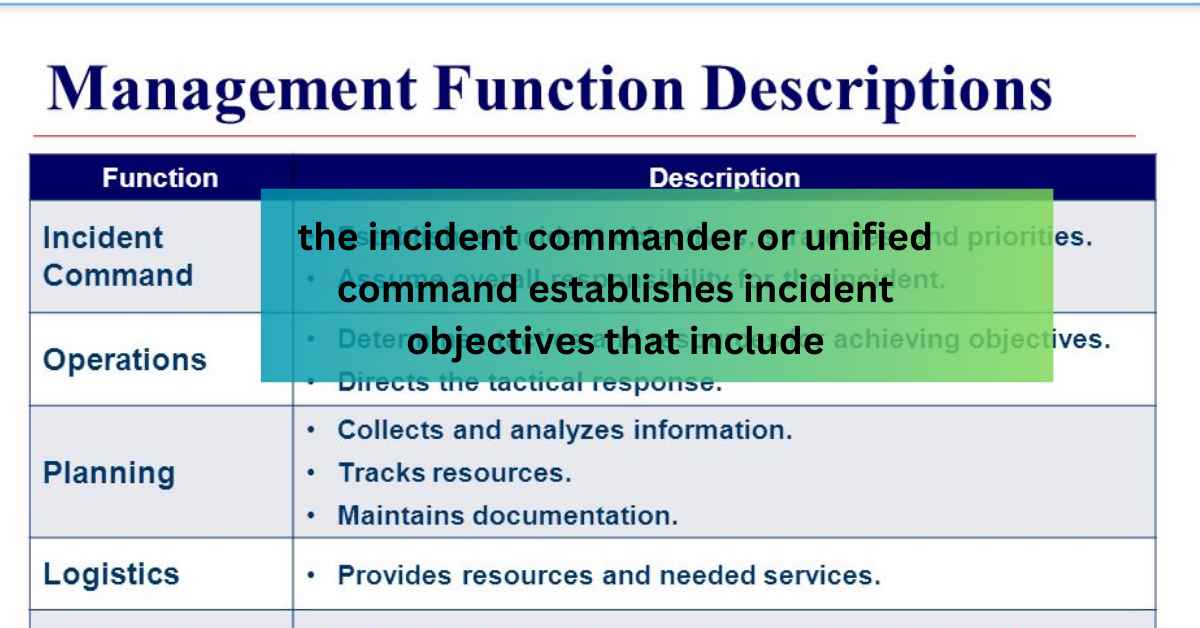
the incident commander or unified command establishes incident objectives that include
Incident commanders and unified command structures play a vital role in managing emergency situations effectively. One of their primary responsibilities is to establish clear and concise incident objectives that serve as a roadmap for response efforts.
In this article, we will delve into the importance of incident objectives, explore their key components, and examine how incident commanders and unified commands work together to ensure the successful management of emergencies.
Understanding Incident Objectives:
Incident objectives are essential guiding principles that help incident commanders and unified commands effectively respond to emergencies. These objectives provide a shared understanding of the desired outcome and assist in aligning all response efforts.
They act as a beacon, directing responders towards a common goal and preventing confusion or miscommunication in high-stress situations.
Components of Incident Objectives:
To establish effective incident objectives, incident commanders must consider several key components. Firstly, objectives should be specific and measurable, allowing responders to gauge their progress.
For example, instead of a vague objective like “minimize damage,” a more specific objective might be “contain the fire within a specific area within two hours.”
Secondly, incident objectives should be realistic and achievable within the given resources and time frame. It is crucial to balance the desired outcomes with the available capabilities to avoid setting unattainable goals that can undermine morale and hinder response efforts.
Also Read: https//www.aainflight.com movies
Thirdly, incident objectives must align with the overall mission and priorities of the incident command structure. They should reflect the broader goals of protecting life, minimizing property damage, and ensuring public safety.
Lastly, incident objectives should be adaptable and subject to revision as the situation evolves. Emergencies are dynamic, and incident commanders must continuously assess and modify objectives to account for changing conditions and emerging challenges.
The Role of Incident Commanders:
Incident commanders are the central decision-makers in emergency response operations. They have the authority to establish incident objectives and oversee the coordination and allocation of resources.
These commanders draw upon their expertise, experience, and situational awareness to set clear objectives that drive the response effort.
Effective incident commanders possess strong leadership and communication skills. They must be able to articulate incident objectives clearly to all involved parties, ensuring a shared understanding of the mission and the specific actions required.
By establishing incident objectives, commanders provide a sense of direction and purpose to the responders, boosting their morale and productivity.
In addition to defining incident objectives, commanders play a critical role in evaluating the progress of response efforts. They monitor the implementation of incident objectives and assess their effectiveness.
If objectives are not being met or need adjustment, commanders can make informed decisions to modify tactics, allocate resources differently, or update objectives based on the changing circumstances.
Unified Command and Incident Objectives:
In complex emergencies involving multiple agencies and jurisdictions, the establishment of a unified command structure is crucial. The unified command brings together various stakeholders, such as law enforcement, fire departments, medical services, and public works, to jointly manage the incident.
Within the unified command structure, incident objectives are established collectively. This collaborative approach ensures that the objectives reflect the input and expertise of all participating agencies.
By sharing information and resources, unified commands can develop comprehensive and integrated incident objectives that consider the specific needs and capabilities of each entity involved.
Unified command fosters effective communication and coordination among different agencies, facilitating a synchronized response. Incident objectives serve as a unifying force, aligning the efforts of various agencies toward common goals.
This integrated approach minimizes duplication of efforts, optimizes resource utilization, and enhances overall incident management.
Conclusion:
In emergencies, incident commanders and unified command structures are responsible for establishing incident objectives that serve as a roadmap for response efforts.
These objectives provide clarity, direction, and a shared understanding of the desired outcomes. By
setting specific, realistic, and adaptable objectives, incident commanders empower responders to work towards a common goal, ensuring effective incident management. The collaborative nature of unified command structures further enhances the development and implementation of incident objectives,
fostering coordination and communication among various agencies. Through their pivotal role, incident commanders and unified command structures play a critical part in the successful resolution of emergencies.
FAQ:
What is the role of an incident commander?
The incident commander is responsible for overall incident management, decision-making, and coordination during emergency situations. They establish incident objectives, allocate resources, and oversee the response effort to ensure an effective and organized response.
Why are incident objectives important?
Incident objectives provide a clear direction and purpose to responders. They help align all response efforts towards a common goal, enhance coordination, and minimize confusion. Incident objectives also serve as a measuring tool to assess progress and effectiveness in managing the incident.
How are incident objectives established?
Incident objectives are typically established by the incident commander in consultation with the unified command structure, if applicable. They consider factors such as the nature of the incident, available resources, and overall mission priorities.
Objectives should be specific, realistic, adaptable, and aligned with the broader goals of protecting life, minimizing damage, and ensuring public safety.
Can incident objectives change during an emergency?
Yes, incident objectives can change based on evolving circumstances and new information. Emergencies are dynamic, and incident commanders must continuously evaluate the situation and make adjustments as needed.
Flexibility is essential to ensure that objectives remain relevant and achievable throughout the response effort.
How does the unified command structure impact incident objectives?
Unified command structures bring together multiple agencies and stakeholders to jointly manage incidents. Within this structure, incident objectives are established collaboratively, incorporating the input and expertise of all involved parties.
The unified command fosters effective communication, coordination, and resource sharing, resulting in comprehensive and integrated incident objectives that consider the specific needs and capabilities of each agency.
You May Also Like

Effortless Ways To Get Real Followers On Snapchat Organically
July 28, 2022
3 Care Recommendations for Each Stage of Parkinson’s
February 6, 2024